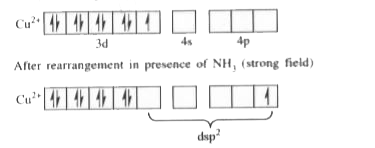V.B. Theory describes the bonding in terms of hybridised orbitals of central atom/ion. The theory mainly deals with the geometry (i.e. shape, magnetic properties)
[Cu(NH3)4]+2 has hydridisation Solution in Telugu
sp3
dsp2
sp2d
none
The correct Answer is:B
Before rearrangement of electrons.

Topper's Solved these Questions
- BOOK - AAKASH SERIESCHAPTER - CO-ORDINATION COMPOUNDSEXERCISE - PRACTICE SHEET - 3 ( Match the following questions)2videos
CO-ORDINATION COMPOUNDS
- BOOK - AAKASH SERIESCHAPTER - CO-ORDINATION COMPOUNDSEXERCISE - PRACTICE SHEET - 3 (Integer answer type Questions)5videos
CO-ORDINATION COMPOUNDS
- BOOK - AAKASH SERIESCHAPTER - CO-ORDINATION COMPOUNDSEXERCISE - PRACTICE SHEET - 3 ( Linked Comprehension type questions Passage - 1:)4videos
CO-ORDINATION COMPOUNDS
- BOOK - AAKASH SERIESCHAPTER - CHEMISTRY IN EVERYDAY LIFE EXERCISE - PRACTICE SHEET - 2 (PRACTICE SHEET -2 (INTEGER ANSWER TYPE QUESTIONS))7videos
CHEMISTRY IN EVERYDAY LIFE
- BOOK - AAKASH SERIESCHAPTER - COMPLEX COMPOUNDS EXERCISE - PRACTICE EXERCISE45videos
COMPLEX COMPOUNDS
Similar Questions
COLUMN-ICOLUMAN-II(A)EDTA(p)Monodeutate(B)DMG(q)Chelate ligand(C)en(r)Bidentate(D)CN−(s)Hexadinatate
02:39View SolutionNi+2 ion forms a searlet red ppt with DMG. It is a …………. Memberd ring.
05:18View SolutionC(aq)o2++S(aq)CN−→ complex (a)
N(aq)i2++dmgNH4OH−−−−→ complex (y)
The CN of Co, Ni in comp,exes (x) & (y) are four
The geometry of complex (x) & (y) are respectivelyView SolutionOne mole Benzene in presence of light on reaction with 'x' moles of Cl2 forms B.H.C. what is 'x' ?
03:19View SolutionThe primary and secondary valencies of the central metal ion in the complex [Co(NH3)6]Cl3 respectively are
05:54View SolutionThe geometry of a complex species can be understood from the knowledge of type of hybridisation of orbitals of central atoms. The hybridisation of orbitals of central atom. The hybridisation of orbitals of central atom in [Be(OH)_(4)]^(-) and the geometry of the complex are respectively
03:05View SolutionOn the basis of valence bond theory, explain geometry, nature of hybridisation, magnetic property and optical isomerism of [Co(ox)3]3−and[CoF6]3−.
02:38View SolutionWith the help of Valence Bond Theory (VBT) explain hybridisation, geometry and magnetic property of [CoF_6]^2 heat fluoridocobaltate (III) ion.
02:15View SolutionExplain the hybridisation, geometry and magnetic property of [Ni(Cl)4]2−.
View SolutionWith the help of Valence Bond theory account for hybridisation, geometry and magnetic property of [Ni(CN)4]2− complex ion [Z for Ni=28]
View SolutionUsing valence bond theory (VBT), account for the geometry, type of hybridization and magnetic property of [NiCl4]2−.
View SolutionWith the help of valence bond theory account for the geometry and magnetic property of (Co(NH3)6)3+.
View SolutionUsing valence bond theory explain geometry, hybridisation and magnetic property of [CoF_6]_3^- (Atomic number of Co = 27).
02:15View SolutionExplain the hybridisation, mgnetic property, geometry, magnetic moment of [Ni(CO)4] using valence bondy theory.
07:18View SolutionExplain the hybridisation, geometry, magentic property and magnetic moment of [Ni(CN)4]2− using valence bondy theory.
09:00View Solution

